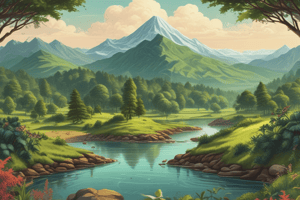Podcast
Questions and Answers
Match the ecological organization levels with their definitions:
Match the ecological organization levels with their definitions:
Population = Group of individuals of the same species in a specific area Community = All the different species that interact in a particular area Ecosystem = A community and its abiotic environment Biome = Large areas characterized by similar climate and vegetation
Match the Earth system components with their descriptions:
Match the Earth system components with their descriptions:
Geosphere = The solid part of the Earth, including rocks and soil Atmosphere = The layer of gases surrounding the planet Hydrosphere = All water on Earth, including oceans and rivers Biosphere = The global sum of all ecosystems and life forms
Match the climate-related terms with their explanations:
Match the climate-related terms with their explanations:
Climate = Long-term atmospheric conditions in a region Weather = Short-term atmospheric conditions at a specific time Greenhouse effect = Trapping of heat in the atmosphere Climate zones = Regions classified based on long-term weather patterns
Match the terrestrial biomes with their characteristics:
Match the terrestrial biomes with their characteristics:
Match the factors that influence climate with their effects:
Match the factors that influence climate with their effects:
Match the aquatic biome types with their examples:
Match the aquatic biome types with their examples:
Match the ecological approaches with their descriptions:
Match the ecological approaches with their descriptions:
Match the non-human causes of climate change with their examples:
Match the non-human causes of climate change with their examples:
Flashcards are hidden until you start studying
Study Notes
Introduction to the Global System
- Ecology studies how organisms interact with each other and their environment.
- Studying ecology helps us understand our planet's ecosystems and biomes.
- Ecological Organization:
- Organism: a single individual of a species
- Population: a group of individuals of the same species living in the same area
- Community: a group of different populations living in the same area
- Ecosystem: a community of organisms and their physical environment
- Biome: a large-scale ecosystem characterized by a particular climate and dominant plant life
- Biosphere: the part of Earth that is inhabited by living organisms
- Approaches to Gathering Ecological Data:
- Observation: observing and recording data about organisms and their environment
- Experimentation: manipulating variables to test hypotheses about ecological relationships
- Modeling: creating mathematical models to simulate ecological processes
- Abiotic Factors: non-living components of an ecosystem (e.g., temperature, sunlight, water, soil)
- Biotic Factors: living components of an ecosystem (e.g., plants, animals, fungi, bacteria)
- Abiotic and biotic factors interact to create a complex and dynamic ecosystem.
The Earth System
- The Earth system is a complex system composed of interconnected components that interact and influence each other.
- Components of the Earth system:
- Geosphere: Earth's solid, rocky outer layer
- Atmosphere: the layer of gases surrounding Earth
- Hydrosphere: all the water on Earth's surface, including oceans, lakes, rivers, and groundwater
- Biosphere: the part of Earth inhabited by living organisms
- Interactions between components:
- The atmosphere regulates Earth's temperature and protects it from harmful radiation.
- The hydrosphere provides water for life and influences climate patterns.
- The biosphere modifies the atmosphere, hydrosphere, and geosphere through biological processes.
Climate vs. Weather
- Climate refers to long-term weather patterns in a region, influenced by factors like latitude, altitude, and proximity to water.
- Weather is the short-term atmospheric conditions at a specific time and place.
Earth's Climate System
- The sun's energy drives Earth's climate.
- The greenhouse effect is the process by which certain gases in the atmosphere trap heat from the sun, warming the planet.
- Greenhouse gases include carbon dioxide, methane, and nitrous oxide.
- Major climate zones:
- Tropical: located near the equator, characterized by warm temperatures and high rainfall
- Temperate: located between the tropics and polar regions, characterized by moderate temperatures and rainfall
- Polar: located at the poles, characterized by cold temperatures and low rainfall
- Climate classifications are determined by temperature, precipitation, and vegetation patterns.
The Impact of Climate on Life
- Climate change refers to long-term shifts in weather patterns, including changes in temperature, precipitation, and sea levels.
- Non-human causes of climate change:
- Forest fires: release large amounts of carbon dioxide into the atmosphere
- Natural disasters: volcanic eruptions, earthquakes, and tsunamis can disrupt climate patterns
- Climate change has significant impacts on ecosystems and the distribution of species.
Land and Aquatic Biomes
- Biomes are large-scale ecosystems characterized by a particular climate and dominant plant life.
- Terrestrial Biomes:
- Tundra: cold, treeless biome with permafrost
- Desert: dry, hot biome with limited vegetation
- Temperate forests: moderate temperature and rainfall, with deciduous trees
- Tropical rainforests: warm, humid biome with high biodiversity
- Aquatic Biomes:
- Freshwater biomes:
- Lakes: standing bodies of water
- Rivers: flowing bodies of water
- Marine biomes:
- Oceans: vast bodies of saltwater
- Coral reefs: diverse underwater ecosystems
- Estuaries: transition zones between freshwater and saltwater
- Freshwater biomes:
- Photic zone: the uppermost layer of water in aquatic biomes, where sunlight penetrates
- Aphotic zone: the deeper layer of water in aquatic biomes, where sunlight does not penetrate
Studying That Suits You
Use AI to generate personalized quizzes and flashcards to suit your learning preferences.




